1982 Topps #480 Steve Carlton - Lot of (50) (Phillies,HOF)
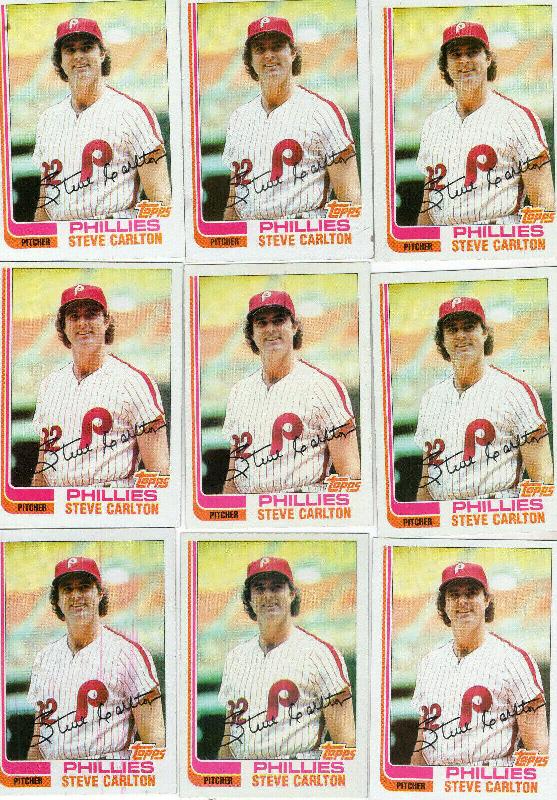

Please wander around the website for more info, prices, values & images
on vintage baseball, football, basketball, hockey, sport and non-sports cards.
Auction's most costly vintage baseball cards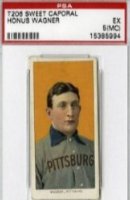
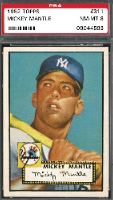
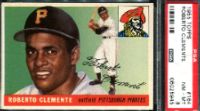
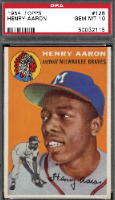
The history of vintage baseball card auctions is long and colorful.
Over 5,000 vintage sports and non-sports items in each weekly auction
T-206 Honus Wagner tobacco cards have sold for upto $2.8 million in
auction. The "Holy Grail of Sports Cards", it's extreme-high auction
value can mostly be attributed to great PR and "auction fever".
It's not close to being the rarest baseball card and Honus Wagner is not
Babe Ruth or Mickey Mantle. Yes, the T-206 set is beautiful & special but
because of the # of cards and scarcities, few collector's try to complete,
which should keep auction competition down compared to say 1933 Goudey
or 1952 Topps baseball card issues. There's a story Wagner banned his card because he was anti-tobacco but there are other stories about financial considerations. You surely have heard of PSA and may even know that this card was the FIRST they ever graded. But did you know that dealer (B.l. .ast.o name encoded) admitted tampering with the card, perhaps having it trimmed down to size, before PSA graded it so highly for the auction.
|

Values of Team Autographed/Signed Baseballs
The value of Autographed Team Balls depends on several items
including:
Click for our current
Autographed/Signed Team Baseball inventory
* The Team or Players * Baseballs signed by more popular teams like the Yankees or Mets tend to be more valuable. Also balls with autographs from popular Hall of Famers increase the value. Some team balls like the 1970's Cincinatti Reds or early Yankees balls have numerous Hall-of-Famers. * Condition of Baseball & Signatures * * Number of Autographs * For a ball to be considered a AUTOGRAPHED TEAM BALL it needs to have the autographs of the Manager (often on the sweet spot), all starters and a good number of other players. Obviously, the more autographs the better. * Authentication * Unfortunately in todays world, it's often best to be sure. Companies like PSA/DBA and UDA (Upper Deck Authenticated), JSA (James Spence) & Beckett provide authentication and Certificates of Authenticity (COA) thet can greatly increase a ball's value. Unfortunately, the cost for verification of team balls often is higher than the cost of the balls themselves. * Significance * Autographed team baseballs from pennant winners and championship teams tend to have much higher values. |

Starting approximately in 1886, sportscards, mostly baseball cards, were often included with tobacco products, for promotional purposes and also because the card reinforced the packaging and protected cigarettes from damage. These sports cards are referred to as tobacco cards in the baseball card hobby. Over the next few years many different companies produced baseball cards. Tobacco cards soon started to disappear as the American Tobacco Company tried to develop a monopoly by buying out other companies.
They were reintroduced in the 1900s, as American Tobacco came under pressure from antitrust action and Turkish competition. The most famous and most expensive, baseball card is the rare T206 Honus Wagner. The card exists in very limited quantities compared to others of its type because Wagner forced the card to be removed from printing. It is widely (and incorrectly) believed that Wagner did so because he refused to promote tobacco, but the true explanation lies in a dispute over compensation.
Soon other companies also began producing baseball and football cards. Sports magazines such as The Sporting News were early entries to the market. Candy manufacturers soon joined the fray and reflected a shift toward a younger target audience for cards. Caramel companies were particularly active and baseball cards were one of the first prizes to be included in Cracker Jacks. World War I soon suppressed baseball card production.
